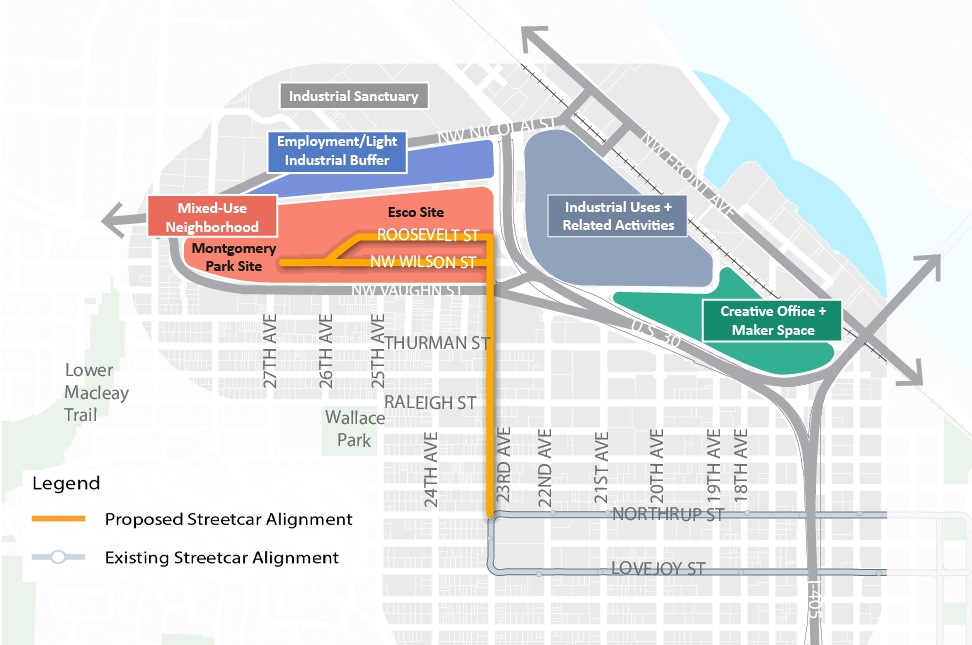Streetcar to Nowhere: Montgomery Park Extension via NW 23rd Roars to Life
Is the Portland Streetcar extension through NW 23rd Avenue a runaway train?
PORTLAND, OREGON - When the City of Portland puts its weight behind a project, you can bet there's more than meets the eye. Moving off the drawing board and into a funding and shovel-ready phase is the extension of the Portland Streetcar to Montgomery Park. This behemoth undertaking stands to completely revamp the North South (NS) Line, cutting directly up Northwest 23rd Avenue through one of the most vibrant business and neighborhood districts in the city.
Slated to break ground in 2026, the project stands as a monument to modern transportation planning: a 1.3-mile extension to the Montgomery Park office building, with a “100% off-wire” leg, free of the overhead wires and poles that traditionally mar electrified streetcar transportation.
But every coin has two sides. Northwest 23rd Avenue, a veritable hub of commerce, is staring down the barrel of significant disruption during the proposed reconstruction. When the machinery roars to life, numerous businesses face an uncertain future. Worse still, the financial burden of this operation will be partly shouldered by the property owners, businesses, and residents themselves, through a mechanism known as a Local Improvement District (LID).
The LID approach requires property owners to share the cost of infrastructure improvements, financed over a span of 20 years. Northwest property owners could be on the hook for tens of millions of dollars in increased property taxes triggered by the LID. This would also, no doubt, increase commercial and residential rents in the affected area.
Since its inception, the financial burden of the Portland Streetcar has been a source of intense criticism. Dr. Eric Fruits from Portland State University likens streetcars to a luxury vehicle - a visual treat but an economic nightmare. “Whenever I see one of the streetcars I think, 'Wow, that's really cute, but it's also really expensive,’” said Dr. Fruits in a 2013 interview. “It's the same thing I would say if I saw someone driving a Bentley. That's a good-looking car, but it's really expensive and I can't afford it.”
The slow speed of the Portland Streetcar is another common criticism. In 2013, The Oregonian columnist Joseph Rose decided to see if he could walk faster than the Portland Streetcar from OMSI to Powell's Books, and handily won. Joseph wrote after the contest: "After lacing up my $50 sneakers and going toe-to-track with the $8.5 million-a-year Portland Streetcar, I’m thinking the city’s oh-so-generically named trolley system should be rebranded the Stumptown Slug."
Despite the flak the Stumptown Slug has drawn over the years, Portland Streetcar's journey is a testament to endurance. What began as a modest 2.4-mile line connecting Portland State University to NW 23rd Avenue on July 20, 2001, has blossomed into a vast network spanning three lines around 16 miles of the city's Central City. The service, though often maligned, has soldiered on for the past 20 years, funded by a mix of TriMet funding, user fares, city parking revenue, and property tax assessments via "Local Improvement Districts."
The Montgomery Park Extension isn't just about extending a transportation mode however. The project promises to create new job opportunities and develop thousands of new housing units in Northwest Portland. But who is really set to benefit from this?
An investigative study titled "The Purpose, Function, and Performance of Streetcar Transit in the Modern U.S. City" suggests that local development and business interests use streetcar development secondarily for transportation, and primarily as a catalyst for urban development. Streetcar systems function as a symbol of a permanent public commitment to an area.
The proposed extension leads directly through the former ESCO Steel site - a post-industrial wasteland with generally abandoned terrain. The land owners have no current zoning compatible with, nor public development plans drawn for, a mixed-use residential area as outlined in the Streetcar plan. Zoning changes are a large part of the vision, though none have been actually changed by the city. A new streetcar line would most likely catalyze zoning updates, which brings the city’s probable intention into focus: development of the barren landscape. More specifically, development of the barren landscape prodded by a streetcar extension heavily financed by property owners in the adjacent, but distant, NW Alphabet District.
Looking closer at the other beneficiaries, the current owners of Montgomery Park, Unico Properties, stand to gain significantly from the streetcar extension. The company boldly claims on their website that, "As a trusted leader in private real estate for almost 70 years, Unico Properties delivers dynamic returns and sustainable development by maximizing every value-add opportunity." The Montgomery Park Streetcar Extension indeed looks to be a very lucrative value-add opportunity.
In this context, the Montgomery Park Streetcar Extension raises more questions than it answers. Is it an innovative solution for urban transportation and development, or is it merely a means for land interests to profit, while the city's residents shoulder the costs? Like the tracks themselves, the answer remains winding and complex.
Corrections:
Unico Properties owns the 18-acre Montgomery Park property. The former ESCO Steel site was purchased in 2019 by a group of local developers.






